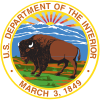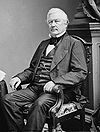Alexander Hugh Holmes Stuart
Alexander Hugh Holmes Stuart | |
|---|---|
 | |
| 3rd United States Secretary of the Interior | |
| In office September 14, 1850 – March 7, 1853 | |
| President | Millard Fillmore Franklin Pierce |
| Preceded by | Thomas M. T. McKennan |
| Succeeded by | Robert McClelland |
| Member of the U.S. House of Representatives from Virginia's 17th district | |
| In office March 4, 1841 – March 3, 1843 | |
| Preceded by | Robert Craig |
| Succeeded by | District eliminated |
| Personal details | |
| Born | April 2, 1807 Staunton, Virginia, US |
| Died | February 13, 1891 (aged 83) Staunton, Virginia, US |
| Political party | Whig |
| Spouse | Frances Baldwin Stuart |
| Children | Briscoe Baldwin Stuart Alexander H.H. Stuart, Jr. Archibald Gerard Stuart Eleanor Augusta Stuart Frances Peyton Stuart Mary Stuart Susan Baldwin "Susie" Stuart Margaret Briscoe Stuart |
| Alma mater | College of William & Mary University of Virginia |
| Profession | Politician, Lawyer |
Alexander Hugh Holmes Stuart (April 2, 1807 – February 13, 1891) was a U.S. political figure. Stuart served as the Secretary of the Interior between 1850 and 1853.
Early years
Stuart was born in Staunton, Virginia, to judge Archibald Stuart, a third-generation American of Scots-Irish origin and his wife Eleanor (nee Briscoe), of distant English ancestry.
Stuart attended the College of William and Mary and graduated from the University of Virginia in Charlottesville. Stuart then studied law and was admitted to the bar in 1828.
Political career
Stuart was a member of the Virginia House of Delegates from 1836 to 1839 and then elected as a Whig to the 27th Congress. Stuart lost the election to the 28th Congress.

From 1850, Stuart served as United States Secretary of the Interior under Millard Fillmore for three years. The department had a culture of political patronage. Stuart didn't change this, but at least gave rules and standards to the political appointments and removed some of the administrative chaos inherent with patronage.
Stuart then served in the Virginia Senate from 1857 through 1861 and was a member of the Virginia state secession convention in 1861. As the Confederacy was established and the United States divided into two hostile camps, both sides moved steadily toward open conflict. A special delegation, composed of Stuart, William B. Preston and George W. Randolph, travelled to Washington, D.C. where they met President Abraham Lincoln on April 12. Finding the President firm in his resolve to hold the Federal forts then in the South, the three men returned to Richmond, Virginia on April 15. Stuart was a delegate to the National Convention of Conservatives at Philadelphia in 1866, and Stuart presented credentials as a Member-elect to the 39th Congress in 1865 but was not admitted.
Stuart was chairman of the Committee of Nine, which was instrumental in restoring Virginia to the Union in 1870, and was again a member of the Virginia General Assembly from 1874 to 1877.
Stuart served as rector of the University of Virginia from 1874 to 1882 and also as president of the Virginia Historical Society, as well as continuing with the practice of law. Stuart died in his hometown of Staunton in 1891 and is buried there at Thornrose Cemetery. Prior to his death, Stuart had been the last surviving member of the Fillmore Cabinet.
His son in law, John M. P. Atkinson (husband of Frances Peyton Stuart) was the tenth president of Hampden–Sydney College from 1857 to 1883.[1]
His home at Staunton, the Stuart House, was added to the National Register of Historic Places in 1972.[2]
Family
- Father: Judge Archibald Stuart, Born March 19, 1757, Died July 11, 1832
- Mother: Eleanor Briscoe (1768–1858)
- Stuart had three brothers, Thomas Jefferson Stuart (born 1793), Archibald P. Stuart (born 1800), and Gerard Briscoe Stuart (born 1805).
- Stuart was the first cousin of congressman Archibald Stuart, whose son was Confederate General J.E.B. Stuart, making him his first cousin, once removed.
- Stuart married Frances Cornelia Baldwin (1815–1888), and with her had 8 children: Briscoe Baldwin Stuart (1837–1859), Alexander H. H. Stuart Jr. (1846–1867), Archibald Gerard Stuart (1858–1888), Eleanor Augusta Stuart (1838–1878), Frances Peyton Stuart (born 1842), Mary Stuart (born 1844), Susan Baldwin Stuart (1848–1867), and Margaret Briscoe Stuart (1855–1932).
References
- ^ Tyler, Lyon Gardiner (1915). Encyclopedia of Virginia Biography. New York: Lewis Historical Publishing Company. pp. 214–215. Retrieved October 21, 2014.
- ^ "National Register Information System". National Register of Historic Places. National Park Service. July 9, 2010.
- United States Congress. "Alexander Hugh Holmes Stuart (id: S001030)". Biographical Directory of the United States Congress.
- The Department of Everything Else: Highlights of Interior History (1989)
External links
- 1807 births
- 1891 deaths
- United States Secretaries of the Interior
- Members of the United States House of Representatives from Virginia
- Virginia State Senators
- Members of the Virginia House of Delegates
- Virginia lawyers
- College of William & Mary alumni
- University of Virginia alumni
- University of Virginia faculty
- People of American Reconstruction
- Politicians from Staunton, Virginia
- People from Augusta County, Virginia
- People of Virginia in the American Civil War
- American people of Scotch-Irish descent
- American people of English descent
- Virginia Secession Delegates of 1861
- Virginia Whigs
- Fillmore administration cabinet members
- Whig Party members of the United States House of Representatives
- 19th-century American politicians


